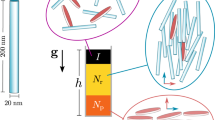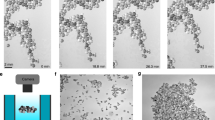Abstract
Colloidal sedimentation has been studied for decades from both thermodynamic and dynamic perspectives. In the present work, binary mixtures of colloidal spheres are observed to separate spontaneously into two distinct layers on sedimentation. Both layers have a high volume fraction and contain distinct compositions of particles. Although predicting these compositions using settling dynamics is challenging, here we show that the compositions are readily predicted thermodynamically by minimizing the gravitational energy of the system. As the random packing fraction of a mixture of spheres exceeds that of monodisperse spheres of either type, the mixture produces a denser suspension that forms the bottom phase. Experimentally, the use of charged particles and low-ionic-strength solutions provides interparticle repulsions that keep the packed particles mobile, avoiding a glassy state that would prevent particles from reaching their equilibrium configuration. We extend this work beyond binary systems, showing similar separated layers for a five-component mixture of particles.
This is a preview of subscription content, access via your institution
Access options
Subscribe to this journal
Receive 12 print issues and online access
$259.00 per year
only $21.58 per issue
Buy this article
- Purchase on Springer Link
- Instant access to full article PDF
Prices may be subject to local taxes which are calculated during checkout




Similar content being viewed by others
References
Bachelor, G. K. Sedimentation in a dilute polydisperse system of interacting spheres. J. Fluid Mech. 119, 379–408 (1982).
Vesaratchanon, S., Nikolov, A. & Wasan, D. T. Sedimentation in nano-colloidal dispersions: Effects of collective interactions and particle charge. Adv. Colloid Interface 134, 268–278 (2007).
Rasa, M. & Philipse, A. P. Evidence for a macroscopic electric field in the sedimentation profiles of charged colloids. Nature 429, 857–860 (2004).
Wang, T., Li, H., Sheng, Y. & Tsao, H. Equilibrium sedimentation profile of dilute, salt-free charged colloids. J. Chem. Phys. 129, 204504 (2008).
Pusey, P. N. & Van Megen, W. Phase behavior of concentrated suspensions of nearly hard colloidal spheres. Nature 320, 340–342 (1986).
Rastogi, V. et al. Synthesis of light-diffracting assemblies from microspheres and nanoparticles in droplets on a superhydrophobic surface. Adv. Mater. 20, 4263–4268 (2008).
Cheng, Z., Russel, W. B. & Chaikin, P. M. Controlled growth of hard-sphere colloidal crystals. Nature 401, 893–895 (1999).
Hoogenboom, J. P., Derks, D., Vergeer, P. & van Blaaderen, A. Stacking faults in colloidal crystals grown by sedimentation. J. Chem. Phys. 117, 11320–11328 (2002).
Yethiraj, A. & van Blaaderen, A. A colloidal model system with an interaction tunable from hard sphere to soft and dipolar. Nature 421, 513–517 (2003).
Chu, J. et al. Crystallization of hard-sphere colloids in microgravity. Nature 387, 883–885 (1997).
Monovoukas, Y. & Gast, A. P. The experimental phase diagram of charged colloidal suspensions. J. Colloid Interface Sci. 128, 533–548 (1989).
Kegel, W. K. & van Blaaderen, A. Direct observation of dynamical heterogeneities in colloidal hard-sphere suspensions. Science 287, 290–293 (2000).
Russel, W. B., Schowalter, W. R. & Saville, D. A. Colloidal Dispersions (Cambridge Univ. Press, 1999).
Donev, A. et al. Improving the density of jammed disordered packings using ellipsoids. Science 303, 990–993 (2004).
Torquato, S. & Jiao, Y. Dense packings of the Platonic and Archimedean solids. Nature 460, 876–879 (2009).
Zou, L., Cheng, X., Rivers, M. L., Jaeger, H. M. & Nagel, S. R. The packing of granular polymer chains. Science 326, 408–410 (2009).
Jiao, Y., Stillinger, F. H. & Torquato, S. Optimal packings of superballs. Phys. Rev. E 79, 041309 (2009).
Berryman, J. G. Random close packing of hard spheres and disks. Phys. Rev. A 27, 1053–1061 (1982).
Visscher, W. M. & Bolsterli, M. Random packing of equal and unequal spheres in 2 and 3 dimensions. Nature 239, 504–507 (1972).
McGeary, R. K. Mechanical Packing of Spherical Particles Vibratory Compacting: Principles and Methods (Plenum Press, 1967).
Brady, J. F. & Bossis, G. Stokesian dynamics. Annu. Rev. Fluid Mech. 20, 111–157 (1988).
Nagele, Gerhard On the dynamics and structure of charge-stabilized suspensions. Phys. Rep. 272, 215–372 (1996).
Anderson, J. L., Rauh, F. & Morales, K. Particle diffusion as a function of concentration and ionic strength. J. Phys. Chem. 82, 608–616 (1978).
Meijer, A. E. J., van Megen, W. J. & Lyklema, J. Pressure-induced coagulation of polystyrene lattices. J. Colloid Interface Sci. 66, 99–104 (1978).
Bensley, C. N. & Hunter, R. J. The coagulation of concentrated colloidal dispersions at low electrolyte concentrations II. Experimental coagulation pressures. J. Colloid Interface Sci. 92, 448–462 (1983).
Handley, D. A. & Hayat, M. A. Colloidal Gold: Principles, Methods and Applications Ed. Vol. 1 (Academic, 1989).
Acknowledgements
The authors thank the Department of Energy (grant no DE-FG02-07ER46414) for funding this project. We also thank Penn State’s Huck Institute of Life Sciences Center for Qualitative Cell Analysis for their assistance and use of their Olympus Fluoview 1000 confocal laser scanning microscope, and M. Boland and D. Palm for their contribution to the initial stages of the research.
Author information
Authors and Affiliations
Contributions
C.G.S. carried out many of the experiments, with help from J.J.M. All authors contributed to understanding the theoretical aspect of the work. C.G.S. and D.V. carried out the initial modelling calculations, which were later refined by all three authors. All authors co-wrote the paper. The work was initiated and guided by D.V.
Corresponding authors
Ethics declarations
Competing interests
The authors declare no competing financial interests.
Supplementary information
Supplementary Information
Supplementary Information (PDF 1777 kb)
Rights and permissions
About this article
Cite this article
Serrano, C., McDermott, J. & Velegol, D. Sediments of soft spheres arranged by effective density. Nature Mater 10, 716–721 (2011). https://doi.org/10.1038/nmat3068
Received:
Accepted:
Published:
Issue Date:
DOI: https://doi.org/10.1038/nmat3068



